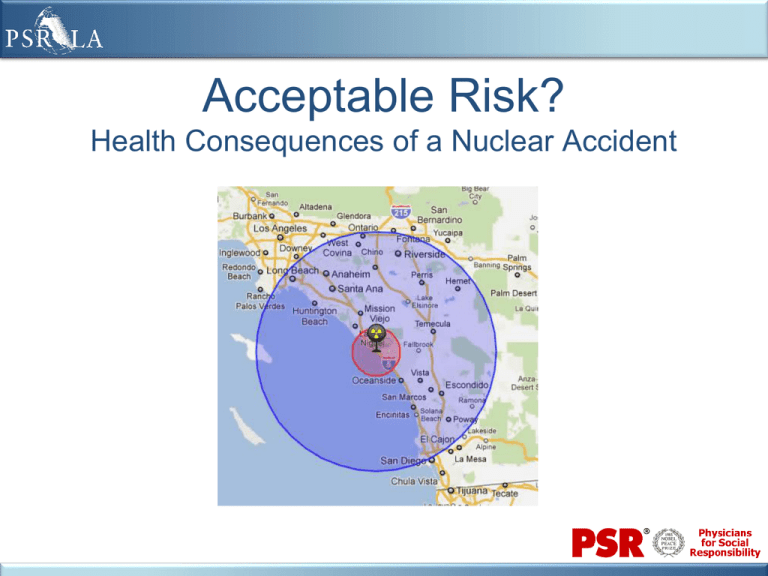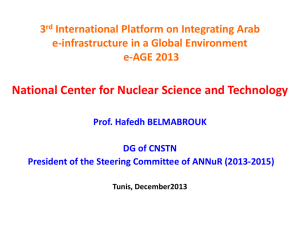Dirty, Dangerous, and Expensive: The Truth About Nuclear POwer
advertisement

Acceptable Risk? Health Consequences of a Nuclear Accident About PSR • PSR is the largest physician-led organization in the country working to protect public health from nuclear and environmental threats. • In the 1960’s, PSR helped end atmospheric nuclear testing by documenting the presence of strontium 90, a radioactive by-product of nuclear tests, in children’s deciduous teeth. • PSR was the American recipient of the Nobel Peace Prize awarded to the International Physicians for the Prevention of Nuclear War in 1985. • PSR-LA was founded in 1980 as a local affiliate of the national organization Physicians for Social Responsibility (PSR). About Me Why am I here? •Pediatrician •Father •Advocate PSR and Nuclear Power PSR opposes nuclear power because of its risk to public health and its association with the proliferation of nuclear weapons. A one-year-old boy is re-checked for radiation exposure after being decontaminated in Nihonmatsu, Fukushiima Every year every commercial nuclear power plant produces 100 pounds of plutonium, increasing the risk of nuclear weapons proliferation. What is Radiation? Ionizing Radiation - Alpha •Alpha particles are relatively large and can only travel short distances, but they can cause a lot of damage. •They are easily stopped by skin and other barriers (like clothing). •Alpha particles are most dangerous when they are in close proximity to cells such as when inhaled. •Plutonium 239 is an alpha emitter and as such is highly carcinogenic when deposited in the lungs. Ionizing Radiation - Beta •Beta particles are high-speed electrons that can penetrate deeper than an alpha particle into tissue. •Alpha and beta particles cause damage through inhalation, ingestion, absorption though the skin, or through a cut in the skin. •Iodine-131 is both a beta and gamma emitter. •Because Iodine-131 is absorbed in the thyroid gland, it causes thyroid cancer. A nurse at a children's health clinic in Warsaw administers an iodine solution to a 3 year-old girl in 1986 Ionizing Radiation - Gamma •Gamma rays are packets of energy that can pass through the body. •If a gamma photon is absorbed by the body, the energy is transferred to the tissues and can cause damage. •Protection from gamma rays takes significantly more barriers. Fukushima workers’ protective gear will stop alpha and beta particles, but it will not stop gamma rays. Radiation Health Effects - How do we know? •Most of the data on the effects of radiation exposure are from studies of the survivors of the bombings of Hiroshima and Nagasaki, intentional medical irradiation, and from a few high dose accidents. •The Hiroshima exposure was a onetime dose largely composed of gamma and x-rays. •This is very different from the releases from Chernobyl and Fukushima which released long-lived radionuclides into the environment. Important Facts of Radiation Exposure • There is no “safe” or non-harmful level of radiation. According to the National Academy’s BEIRVII Report, increase of radiation exposures increases a person’s risk of cancer. • We are all exposed to radiation: background radiation, with which we evolved, and medical radiation, which may be necessary and life saving as determined and controlled by the patient and physician. • Radiation exposure that occurs with the release of radiation throughout the nuclear fuel cycle, nuclear weapons use and testing, and both the “controlled” and catastrophic releases of long lived radionuclides from the nuclear power industry is very different and is not “natural” and should not be included as acceptable “background”. Misconceptions and Fallacies We have been told by industry and government officials that 100 mSV is a threshold below which there are “No detectable health effects.” NRC Chairman Gregory Jackzko The BEIR report concluded specifically that a 100 mSv dose confers a one in one hundred risk of getting cancer. While that risk may be relatively low for one person, if 100 people receive that dose, one of them will get cancer. And if a million people are exposed to that dose, ten thousand of them will get cancer. This cannot be considered a “safe threshold.” External vs. Internal Emitters If you are near an external source of radioactivity, you are only exposed while you are near it. If you inhale or ingest a radioactive particle, that particle will continue to irradiate you for as long as the particle is in your body and remains radioactive. Not All Exposed are Affected Equally •Women are significantly more vulnerable to radiation exposure than men. •Children are much more vulnerable than adults to the effects of radiation. •Fetuses are even more vulnerable. Vika Chervinska, an eight-year-old Ukrainian girl suffering from cancer waits to receive treatment with her mother at the children's hospital in Kiev. April 18, 2006. Photo: Atlantic Radionuclides Associated with Nuclear Power Radionuclide Health/Environmental Effects Tritium Linked to developmental problems, reproductive problems, genetic abnormalities. Radium Lymphoma, bone cancer, leukemia, aplastsicanemia linked with inhalation. Other cancers with external exposure. Technetium-99 Cancer linked to ingestion (contaminated food and water). Iodine-131 Linked to thyroid malfunction/cancer. Combines with soil and organic materials easily. Cesium-137 Can cause cancer 10 – 30 years after ingestion, inhalation, or absorption. Moves easily in environment, impossible to clean up. Strontium-90 Chemically similar to calcium. Can cause bone cancer, cancer near bones, and leukemia. Plutonium Contaminant in dust. Extreme risk of cancers, kidney damage. Can stay in the body for decades. Acute Radiation Effects Sv REM 50-100 mSv 500 mSv 550 mSv 700 mSv 750 mSv 900 mSv 1 4 10 5-10 50 55 70 75 90 100 400 1,000 20 2,000 Health Effect changes in blood chemistry nausea fatigue vomiting hair loss diarrhea hemorrhage possible death destruction of intestinal lining internal bleeding and death damage to central nervous system loss of consciousness; and death Time to Onset hours 2-3 weeks within 2 months 1-2 weeks minutes hours to days Santa Susana Field Laboratory In 1959, a partial nuclear meltdown occurred at the Santa Susana Field Laboratory in the hills above Simi Valley. Three Mile Island The accident at Three Mile Island in 1979 was rated a 5 on the 7-point International Nuclear Event Scale (INES). A level 5 accident entails the “Release of large quantities of radioactive material within an installation with a high probability of significant public exposure.” Chernobyl Source: Janusz Pudykiewicz, Meteorological Service of Canada. Units are becquerel/kg at 850 mb. level. A becquerel is one nuclear decay per second. Efrem Lukstaky/AP) Chernobyl Mothers with their babies wait to board the trains which will eventually take them to neighboring Belarus and Russia, as well as other parts of the Ukraine to be resettled. Nastasya Vasilyeva, 67, cries at her home in the devastated village Rudnya in an isolated zone some 45km (28 miles) from Ukraine's Chernobyl nuclear power plant, April 3, 2006. |AP Photo|Sergey Ponomarev| Fukushima Daiichi Fukushima Health Effects NRC Near-Term Task Force Review of Insights - July 12, 2011 San Onfre According to a 1982 NRCstudy, a meltdown at one of San Onofre reactors could cause: 130,000 'prompt' fatalities; 300,000 latent cancer, and 600,000 cases of genetic defects within 35 miles of the site. Since then, the population in the area has increased substantially. Contaminating the Future A Ferris Wheel in the ghost town of Pripyat, which was evacuated after a nuclear disaster in Chernobyl, April 13, 2006. |Reuters|Gleb Garanich| Prevent What We Cannot Cure • Nuclear power is dangerous, and fraught with safety and security hazards that do not happen with other technologies. • If a nuclear reactor malfunctions in a major way, the environment and thousands of lives are immediately put at risk - possibly for decades and even centuries to come. • PSR’s motto is that we must “prevent what we cannot cure.” We believe that the best way to prevent a nuclear accident is to move to safer, cleaner, reliable energy sources.








